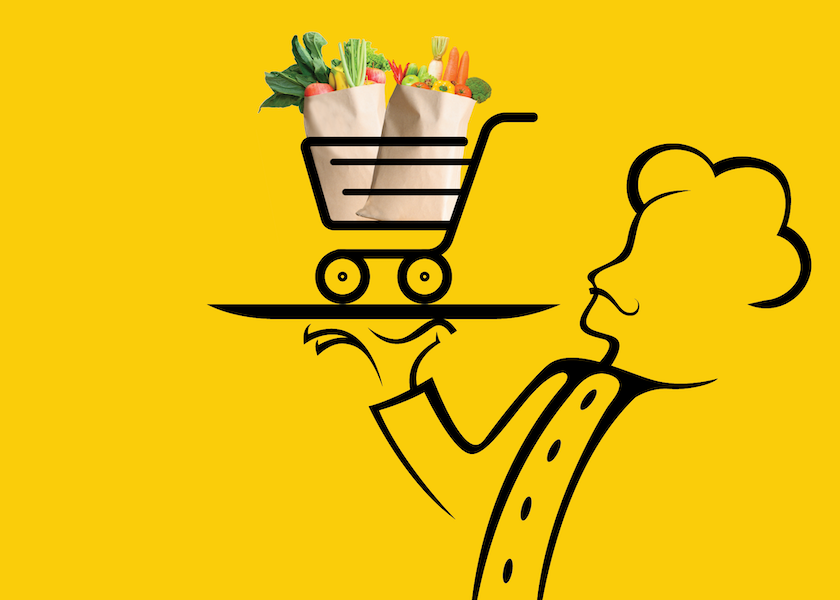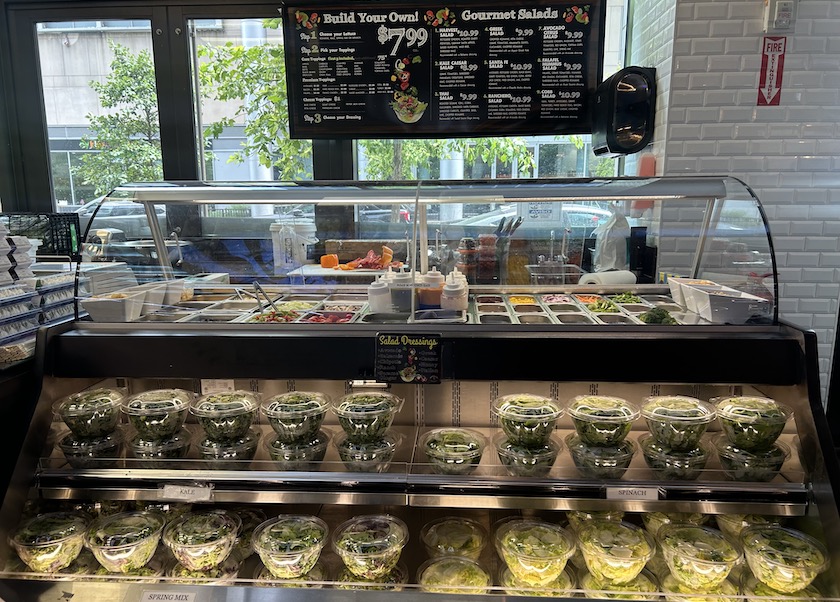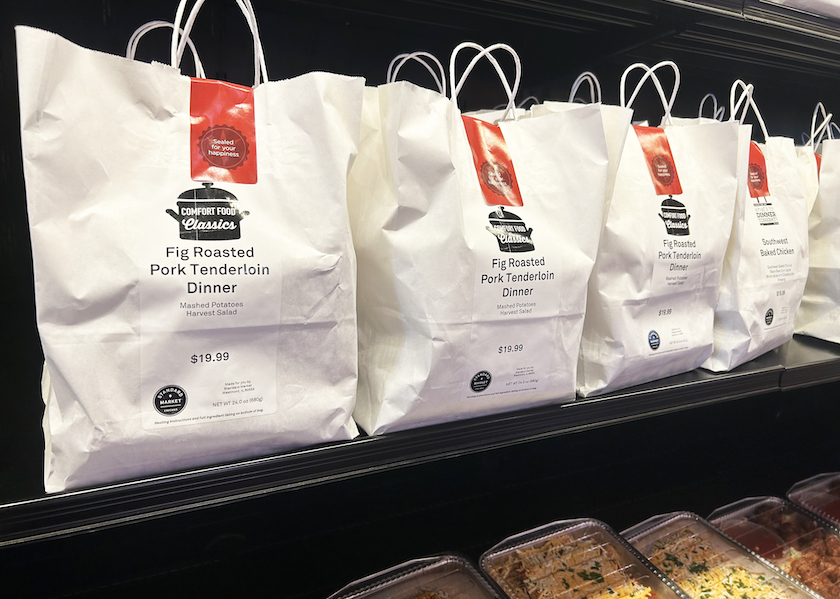Supermarkets ask: Dine in, carry out or delivery?

Wander through some grocery stores and you feel as if you’re in a buffet, fast-casual restaurant or food court. The chef-helmed delis and salad bars tempt shoppers to carry out some kale salad punctuated with pink pomegranate arils and pine nuts. The caramelized, crispy Brussels sprouts glisten with bacon, and the cold, crunchy broccoli salad is sweetened with raisins.
Meal kits are proliferating for shoppers who still want to cook but with shortcuts. In between, there are heat-and-eat options — sometimes delivered through a third-party app.
“When you go in a store, we’re foodservice as well. You can sit down or carry out. We’re trying to meet the customer where they want to be,” said Steve Mayer, president of Bashas’, based in Chandler, Ariz.
With the return of restaurants after tanking in 2020 and 2021, the competition has fired up in 2023 for grocery retailers trying to nab share of the consumer’s 35 meals a week.
In total food and beverage sales, rising inflation increased the retail share in 2022, but foodservice improved in the first quarter of 2023, reported Circana, the consumer behavior analytics firm that merged IRI and NPD's retail-foodservice power.
Bashas’ offers foods from popular local eateries, and it hired trend-focused chefs at AJ’s, its gourmet banner, to meet the demand.
Produce in foodservice-oriented retail
As supermarkets transform at an ever-quickening pace, where does produce play a role?
International Fresh Produce Association’s global Technomic data revealed 64% of consumers use foodservice in supermarkets a few times a month or more. Only 17% of consumers believe that fresh produce is not represented well in supermarket foodservice, but two-thirds of shoppers want more prepared options that are healthful, as well as more heat-and-eat vegetables, side dishes and globally inspired choices, according to FMI, The Food Industry Association.

“We’re really trying to offer restaurant-quality meals at our stores,” said Mimmo Franzone, vice president of merchandising at Vaughan, Ontario-based Longo’s. With 18 years in produce, Franzone spoke at the May 24 virtual town hall, “Foodservice: The Retail Effect and Where Consumers Shop Food," hosted by International Fresh Produce Association.
“It’s making sure we have every occasion covered, No. 1,” he said. “And No. 2, it's making sure that however the guest wants to prepare the food, we have that covered as well, whether it’s ready to eat or ready to cook.”
One Longo’s program, Take It, Make It, Learn It, offers a monthly recipe in all forms of preparation: ready to eat, ready to heat and a recipe via QR code.
Regarding fresh fruits and vegetables: “It's always around fresh sides and the latest and greatest, what’s seasonally relevant,” Franzone said.
The dollar share of ready-to-eat produce meals jumped 8.6 percentage points compared with 2022, and added-value items jumped 8.2 points in the last 52 weeks ending April 23, Circana’s IRI data shows. Raw ingredients jumped 4.7 points.
“It's consumers who are looking for something that's convenient and readily available, but it's also not taking away from those produce occasions. So, we didn't see a dip on the produce [department] side of Brussels sprouts when a consumer was buying Brussels sprouts from the deli,” said Circana's Kate Allmandinger in the town hall with Franzone. “Really, it was just increasing the size of the prize — or size of our pie — of the occasions of eating for vegetables because it was making it so much easier for consumers just to pick up and have.”
Convenience and restaurant quality
Retailers must take the dollar from restaurants with competitive meal convenience and tantalizing options.
Strategies include offering meal kits online and in-store, like Kroger’s Home Chef partnership and ShopRite’s DoorDash partnership for Fresh to Table express pickup and delivery at two Klein’s Family Markets locations in Maryland, launched in May. Fresh to Table focuses on produce and other fresh departments, offering three formats: Prep & Eat, Heat & Eat and Grab & Eat.
Related: ShopRite launches two more fresh-meal stores inside Klein’s Family Markets
From big chains to independent grocers, retailers are providing in-store dining. And grocery-restaurant partnerships mean popular restaurant menu items can be found in-store. Delis, salad and hot bars are growing ever-more elaborate.
“They're really trying to bring almost that restaurant-quality meal into your home,” Allmandinger said.
Longo’s partnered with KitchenHub, a Toronto-based virtual food hall offering delivery or pickup of the area’s hottest restaurant menu items, like Mandy’s Salads. Longo’s makes it in-store in a ghost kitchen, where shoppers can pick it up after ordering it on the app and eat it at in-store seating, take it home or have a third-party app driver deliver it to their home or work.

“It’s a fresh offering that's visible to the consumer because you can see it in the kitchens. It’s taken off. It’s been incremental to our business,” Franzone said. “We have full-blown salad bars, and they're still going. There's enough sand to play in the sandbox, right?”
In The Packer’s 2023 Organic Fresh Trends report, almost 53%, or 538 of 1,017 survey respondents, said they’ve bought more value-added (fresh-cut fruit and veggies, ready-to-heat, ready-to-eat) produce in the past five years.
And when asked for their primary reason for the increased purchases of value-added produce, about 44% said convenience and time-savings, more than 35% said flavor and taste, almost 14% said value and more than 7% said reduced waste.
Produce is growing in added-value and ready-to-eat solutions, Allmandinger said. “Consumers are really telling us they want convenience, not just in our surveys but in what they’re buying in the store,” she said.
Off-premises was 75% of restaurant traffic in 2022, up 15% from February 2020, according to the National Restaurant Association.
Retailers can compete with takeout meals, which don't provide ambiance. DoorDash’s partnership with Aldi is an example of another delivery company collaborating with a grocery chain to offer popular delivery foods at retail to heat and eat or keep on hand at home, Sloan said in her report.
Prices
Inflationary prices and budget-conscious shoppers haven’t stopped this trajectory, possibly because foodservice-level convenience feels less expensive at the grocery store than it does at restaurants.
The grocery food price index rose 5.8%, while restaurant food rose 8.3% in the last 12 months, shows a June Consumer Price Index report from the U.S. Bureau of Labor Statistics.
Inflation for fresh fruits and vegetables rose just 0.6% from May 2022 to May 2023, the report said.

Still, convenience can win over price.
“It's so expensive to eat out. We were so used to cooking at home. But guess what? In the first quarter of this year, retail has already lost 2.5 percentage points of sales share back to foodservice, even though we have inflation,” Circana’s Jonna Parker said June 8 at IFPA’s Retail Conference in the suburbs of Chicago. “You might point to the economy, market, inflation … but the reality is, we are human. And there is a perception that the food at retail is hard, and hard to find. Not aligned to my needs.”
That perception has to change for retailers to win more produce-filled meal share from restaurants.
Related: Circana's Jonna Parker: What grocery transformation means for produce
In PMG’s LinkedIn poll in the Fresh Produce Industry Discussion Group, 77 voters were asked, “What ways do you think retailers can best compete with foodservice for the share of the consumer's daily meals filled with produce?” Of 77 voters, 32% said meal kits, own or third party; 31% said in-store cafes and restaurants; 26% said elaborate salad bars and deli; and 10% said restaurant partnerships.
Whole Foods Market’s newest store in Washington, D.C., has a prepared foods section with Kikka Sushi, New York-style pizza, bars of hot food and crisp salads, plus an on-site dining area.
“I notice, as with Whole Foods, that the salad, hot bar and soup are a huge hit. I, for one, am a fan,” commented Windy Hale of Hale Produce, Delray Beach, Fla.
At one of the Bashas’ banners, in-store birthday parties and holidays are big. “When you talk about the foodservice aspects of what we do, we're like a 360-degree experience where you can just pick and choose what you want,” Mayer said.
— This article was featured in the July-August issue of PMG magazine. Check out the digital version of this issue and others.







